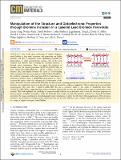Files in this item
Manipulation of structure and optoelectronic properties through bromine inclusion in a layered lead bromide perovskite
Item metadata
| dc.contributor.author | Yang, Linjie | |
| dc.contributor.author | Xuan, Wenye | |
| dc.contributor.author | Webster, David E. J. | |
| dc.contributor.author | Krishnan Jagadamma, Lethy | |
| dc.contributor.author | Li, Teng | |
| dc.contributor.author | Miller, David N. | |
| dc.contributor.author | Cordes, David B. | |
| dc.contributor.author | Slawin, Alexandra M. Z. | |
| dc.contributor.author | Turnbull, Graham | |
| dc.contributor.author | Samuel, Ifor D. W. | |
| dc.contributor.author | Chen, Hsin-Yi Tiffany | |
| dc.contributor.author | Lightfoot, Philip | |
| dc.contributor.author | Dyer, Matthew S. | |
| dc.contributor.author | Payne, Julia L. | |
| dc.date.accessioned | 2023-05-03T14:30:10Z | |
| dc.date.available | 2023-05-03T14:30:10Z | |
| dc.date.issued | 2023-05-23 | |
| dc.identifier | 283994729 | |
| dc.identifier | cd3557f4-2942-4d50-aa57-c5f15d44766b | |
| dc.identifier | 85159618374 | |
| dc.identifier.citation | Yang , L , Xuan , W , Webster , D E J , Krishnan Jagadamma , L , Li , T , Miller , D N , Cordes , D B , Slawin , A M Z , Turnbull , G , Samuel , I D W , Chen , H-Y T , Lightfoot , P , Dyer , M S & Payne , J L 2023 , ' Manipulation of structure and optoelectronic properties through bromine inclusion in a layered lead bromide perovskite ' , Chemistry of Materials , vol. 35 , no. 10 , pp. 3801–3814 . https://doi.org/10.1021/acs.chemmater.2c03125 | en |
| dc.identifier.issn | 0897-4756 | |
| dc.identifier.other | ORCID: /0000-0002-9527-6418/work/134491311 | |
| dc.identifier.other | ORCID: /0000-0002-4339-2484/work/134491330 | |
| dc.identifier.other | ORCID: /0000-0002-5366-9168/work/134491414 | |
| dc.identifier.other | ORCID: /0000-0003-3324-6018/work/134491441 | |
| dc.identifier.other | ORCID: /0000-0001-7048-3982/work/134491532 | |
| dc.identifier.uri | https://hdl.handle.net/10023/27499 | |
| dc.description | Funding: J.L.P. thanks the University of St Andrews for funding and the Carnegie Trust for a Research Incentive Grant (RIG008653). The authors also thank EPSRC for funding (EP/T019298/1, EP/R023751/1 and EP/V034138/1). L.K.J. thanks UKRI for a Future Leaders Fellowship (MR/T022094/1). | en |
| dc.description.abstract | One of the great advantages of organic–inorganic metal halides is that their structures and properties are highly tuneable and this is important when optimizing materials for photovoltaics or other optoelectronic devices. One of the most common and effective ways of tuning the electronic structure is through anion substitution. Here, we report the inclusion of bromine into the layered perovskite [H3N(CH2)6NH3]PbBr4 to form [H3N(CH2)6NH3]PbBr4·Br2, which contains molecular bromine (Br2) intercalated between the layers of corner-sharing PbBr6 octahedra. Bromine intercalation in [H3N(CH2)6NH3]PbBr4·Br2 results in a decrease in the band gap of 0.85 eV and induces a structural transition from a Ruddlesden–Popper-like to Dion–Jacobson-like phase, while also changing the conformation of the amine. Electronic structure calculations show that Br2 intercalation is accompanied by the formation of a new band in the electronic structure and a significant decrease in the effective masses of around two orders of magnitude. This is backed up by our resistivity measurements that show that [H3N(CH2)6NH3]PbBr4·Br2 has a resistivity value of one order of magnitude lower than [H3N(CH2)6NH3]PbBr4, suggesting that bromine inclusion significantly increases the mobility and/or carrier concentration in the material. This work highlights the possibility of using molecular inclusion as an alternative tool to tune the electronic properties of layered organic–inorganic perovskites, while also being the first example of molecular bromine inclusion in a layered lead halide perovskite. By using a combination of crystallography and computation, we show that the key to this manipulation of the electronic structure is the formation of halogen bonds between the Br2 and Br in the [PbBr4]∞ layers, which is likely to have important effects in a range of organic–inorganic metal halides. | |
| dc.format.extent | 14 | |
| dc.format.extent | 6153143 | |
| dc.language.iso | eng | |
| dc.relation.ispartof | Chemistry of Materials | en |
| dc.subject | QD Chemistry | en |
| dc.subject | DAS | en |
| dc.subject | MCC | en |
| dc.subject.lcc | QD | en |
| dc.title | Manipulation of structure and optoelectronic properties through bromine inclusion in a layered lead bromide perovskite | en |
| dc.type | Journal article | en |
| dc.contributor.sponsor | EPSRC | en |
| dc.contributor.sponsor | EPSRC | en |
| dc.contributor.institution | University of St Andrews. School of Chemistry | en |
| dc.contributor.institution | University of St Andrews. School of Physics and Astronomy | en |
| dc.contributor.institution | University of St Andrews. Centre for Energy Ethics | en |
| dc.contributor.institution | University of St Andrews. Energy Harvesting Research Group | en |
| dc.contributor.institution | University of St Andrews. Institute of Behavioural and Neural Sciences | en |
| dc.contributor.institution | University of St Andrews. EaSTCHEM | en |
| dc.contributor.institution | University of St Andrews. Sir James Mackenzie Institute for Early Diagnosis | en |
| dc.contributor.institution | University of St Andrews. Centre for Biophotonics | en |
| dc.contributor.institution | University of St Andrews. Condensed Matter Physics | en |
| dc.identifier.doi | https://doi.org/10.1021/acs.chemmater.2c03125 | |
| dc.description.status | Peer reviewed | en |
| dc.identifier.grantnumber | EP/R023751/1 | en |
| dc.identifier.grantnumber | EP/T019298/1 | en |
This item appears in the following Collection(s)
Items in the St Andrews Research Repository are protected by copyright, with all rights reserved, unless otherwise indicated.

